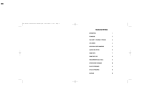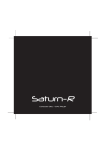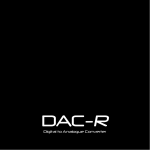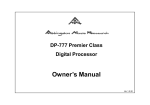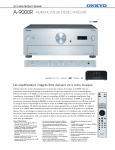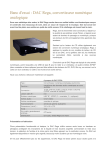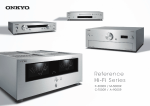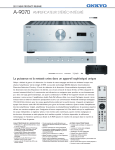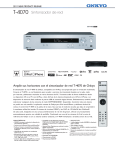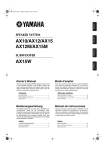Download Rega Cursa 3 Specifications
Transcript
Dac manual:Cursa manual.qxd 29/11/2010 17:12 Page 1 CONTENTS INTRODUCTION 1 TECHNOLOGY 2 FRONT PANEL INDICATORS & CONTROLS 3 BACK PANEL 4 IN USE & DIGITAL OUTPUT 5 FILTER SETTINGS 6 CONNECTIVITY 7 USB CONNECTIVITY 8 96kHz-192kHz OPERATION 9 TECHNICAL SPECIFICATIONS 10 TROUBLESHOOTING 11 TROUBLESHOOTING 12 GLOSSARY OF TERMS 13 Dac manual:Cursa manual.qxd 29/11/2010 17:12 Page 3 INTRODUCTION TECHNOLOGY The Rega DAC is a 16/20/24-bit at 32kHz to 192kHz digital to analogue converter incorporating an enhanced version of the Rega designed circuit. The input stage comprises a Wolfson digital receiver with a high stability low jitter clock driving the receiver PLL. The receiver and PLL have their own dedicated power supplies. The DAC stage comprises of a pair of parallelconnected Wolfson WM8742 DAC’s, which are driven via a buffer stage, which ensures the integrity of the data being fed to the DAC IC’s – similar to the arrangement used in the Isis (Rega’s reference CD player). Developed to be simple to set up and use, the Rega DAC is designed to optimise performance from any two channel PCM digital audio source. With the PC (although a somewhat contentious issue in hi-fi circles) now widely accepted as a creditable medium for storing and streaming music. The use of high quality lossless files such as WAV, FLAC and ALAC offer performance through the DAC equal to and in some cases better than red book CD. Great care has been taken to remove noise generated by the PC and other input sources. During development this was identified as a major drawback with many DAC’s on the market today. The output amplifier employs a discrete differential multiple feedback filter and output amplifier, with a high cut-off frequency for use with higher sample rates. We decided not to use a sample rate converter and process the data at the incoming sample rate which keeps the signal processing to a minimum. Jitter was minimised by synchronously clocking the digital data with our receiver PLL (removing any jitter from the input signal). The Rega DAC has been designed and engineered to achieve the highest performance in its class. We hope you enjoy this Rega product for many years to come. All the capacitors associated with the analogue signal path are Nichicon FG bypassed with MMK polyester capacitors, and low impedance conductive polymer capacitors are used for DAC decoupling. The power supply utilizes a toroidal transformer, fast rectifier diodes and again Nichicon FG capacitors. There is a power supply for the control microcontroller, separate from the digital & analogue audio stages. Special attention being paid to the inter IC control signals ensuring the control data noise is kept to a minimum. 1 2 The Rega DAC housed in a custom aluminium and steel case boasts a pair of Wolfson DAC IC’s and 5 user selectable digital filters, two isolated Co-axial inputs, two Toslink SPDIF inputs and an isolated USB input. Dac manual:Cursa manual.qxd 29/11/2010 17:12 Page 5 FRONT PANEL INDICATORS AND CONTROLS BACK PANEL Power on/off (button above Rega logo) When the power button is pressed the Rega logo illuminates to indicate power is on. Digital Inputs Input Locked indicator This indicates the digital input signal is valid and the PLL in the receiver is locked. When the Input Locked LED is off the soft mute is activated. Input This button selects the 5 available digital inputs. Push to advance to the next input as follows: USB Optical 1 Optical 2 Co-axial 3 Co-axial 4 Sample rate LED’s (only valid when Input Locked is on) 32K – Indicates the incoming sample rate is 32kHz 44.1/48K – Indicates the incoming sample rate is 44.1 or 48kHz 88.2/96K – Indicates the incoming sample rate is 88.2 or 96kHz 192K – Indicates the incoming sample rate is 176.4 or 192kHz 3 USB - type B connector/Isolated Optical Digital Input 1 - Optical/Toslink Optical Digital Input 2 - Optical /Toslink Co-Ax Digital Input 3 - Isolated 75Ω Co-axial Phono Co-Ax Digital Input 4 - Isolated 75Ω Co-axial Phono Digital output (via receiver & PLL) -SPDIF Optical Toslink Co-axial/Phono Isolated 75Ω Analogue Output Left and Right Phono Power Mains/line input IEC C5 type Fuse Fuse holder 4 Dac manual:Cursa manual.qxd 29/11/2010 17:12 Page 7 IN USE FILTER SETTINGS Power-up the DAC using the power switch on the front panel. After a few seconds you will hear an audible click from the output mute relay and the analogue audio will be active. Please note: The front panel will display the previously selected setting’s displayed before the unit was last powered down. The cut-off points of the filters are in the upper end of the frequency range. However, due to complex technical phenomena, this will have an effect lower in the frequency band. For further description see the glossary of terms. These settings are a matter of personal taste and may only offer subtle changes. We suggest using Filter setting 1 and trying different settings with various equipment. If the currently selected input has an active source connected the Input Locked LED along with the appropriate incoming sample rate LED will illuminate. Unless the Input Locked LED is lit the sample rate indication is irrelevant. By pressing the input selection switch you can select any one of the inputs. When the Input Locked LED is off, or there is a transmission error the internal soft mute is activated automatically. By pressing the Filter selection switch you can select any one of the 5 available digital filters 1,2,3,4 or 5. (The exact properties of these filters are outlined on the opposite page). Filter setting switch & LED’s Push to advance to the next filter. Filter settings 1 – 5 (low sample rates 32/44.1/48K) 1 Linear phase half-band filter 2 Minimum phase soft-knee filter 3 Minimum phase half-band filter 4 Linear phase apodising filter 5 Minimum phase apodising filter DIGITAL OUTPUT The digital output mirrors the selected input. For example when input 2 has been selected the digital output will be the signal present on input 2 but cleaned up and re-clocked, this can be used to drive an auxiliary piece of equipment if so desired. Filter settings 1 – 5 (medium & high sample rates 88.2/96 & 176.4/192K) 1 Linear phase soft-knee filter 2 Minimum phase soft-knee filter 3 Linear phase brickwall filter 4 Minimum phase apodising filter 5 Linear phase apodising filter 5 6 Dac manual:Cursa manual.qxd 29/11/2010 17:12 Page 9 CONNECTIVITY (examples) 1 USB A-B/ 2 OPTICAL/3 CO-AXIAL This page offers ‘suggested connectivity’, with so many products offering a number of options it is important to check the manual of the product your are connecting, for the appropriate or optimum output connection and settings required to operate properly. USB CONNECTIVITY Connect a USB A-B type lead (as illustrated) from the DAC USB to a USB output on your PC. The standard Windows ‘found new hardware’ dialogue will be displayed on your PC in the bottom right hand corner of the screen. USB A-B lead (not supplied) The DAC will be recognised as ‘USB AUDIO DAC’. Installation should be automatic as no driver disc is required. After a short period ‘your new hardware is installed and ready to use’ should appear to confirm that connection and installation has been successful. It is recommended to switch off any other system sounds emitted by the PC via the control panel. The DAC will automatically become the default for your PC whilst connected. Once disconnected the previous default will be restored. If this does not happen you can manually reset as follows : Note: This unit only accepts two-channel PCM digital audio. You cannot connect a Dolby Digital 5.1/7.1 or a DTS signal as they will not be recognised. If you wish to connect a DVD or similar device, please ensure that the sound output of your player is set to two-channel PCM. 7 Windows XP - Control panel/Sounds and audio devices/Audio/Sound Playback Windows Vista/Windows 7 - Control Panel/Hardware and Sound/Manage Audio Devices/select ‘USB AUDIO DAC’ from list. Mac OS - System Preferences/Sound Output/Select Audio USB DAC. 8 Dac manual:Cursa manual.qxd 29/11/2010 17:12 Page 11 96kHz & 192kHz OPERATION The Rega DAC can operate at 192kHz when used with a capable soundcard connected via the Co-axial or optical input. Due to the limitations of some operating systems the exact configuration and set-up can vary from one PC/Laptop to another. If you are constructing a high sample rate music server, we recommend that the frequency response and THD of the final unit complete with the DAC, soundcard and player is checked using high frequency test tones with suitable measuring equipment to ascertain the playback chain is capable of true 96 & 192K operation. This test will require specialist test tones and equipment. Loudspeakers should not be used as certain frequencies could potentially damage the drive units. Please note: Some PC/Laptop or disc players are only capable of a maximum sample rate of 48kHz. The USB will only work at 32/44.1/48kHz 16-bit even if you have a 96kHz & 192kHz playback configuration. TECHNICAL SPECIFICATIONS DAC Wolfson WM8742 Frequency Response (100KΩ load) Low data rate 44.1/48KHz Filter 2 = 10Hz -0.05dB to 20KHz -0.1dB Medium data rate 88.2/96KHz Filter 2 = 10Hz -0.05dB to 30KHz -1dB High data rate 176.4/192KHz Filter 2 = 10Hz -0.05dB to 41KHz -1dB Total Harmonic Distortion (24bit 96KHz) = 0.006% @ 1KHz Signal To Noise Ratio -105dB (relative to maximum output level with a 100Hz to 22KHz bandwidth) Maximum output level = 2.175V into 100KΩ load Bit resolution 16 to 24bit (USB is limited to 16bit) Supported data rates = 32, 44.1, 48, 88.2, 96, 176.4, 192KHz Digital inputs USB Isolated (16bit 32/44.1/48KHz) Input 1 Optical/Toslink (24bit 32/44.1/48/88.2/96/176.4/192KHz) Input 2 Optical /Toslink (24bit 32/44.1/48/88.2/96/176.4/192KHz) Input 3 Isolated 75Ω Co-axial (24bit 32/44.1/48/88.2/96/176.4/192KHz) Input 4 Isolated 75Ω Co-axial (24bit32/44.1/48/88.2/96/176.4/192KHz) Digital output (via receiver & PLL) - SPDIF Optical Toslink Isolated 75Ω Co-axial/SPDIF Power 230v/115v/7.6W Dimensions in cm W 21.5 x D 27 x H 8 Weight 4.0 Kg 9 10 Dac manual:Cursa manual.qxd 29/11/2010 17:12 Page 13 TROUBLESHOOTING TROUBLESHOOTING No power - no LED’s illuminated Power ON - No output No Is the mains supply connected and the socket switched on? Correct the fault Yes Correct the fault Yes No Is the front panel on/off switch fully depressed? Correct the fault (contact Rega dealer if faulty) Yes No Are the matching inputs on the amplifier correclty selected? Correct the fault Yes Yes Has the fuse in the mains plug blown? Replace with the same rated fuse No Is the correct input on the DAC selected and the input locked LED illuminated? No Select correct input on the DAC Yes No In the mains socket live? (plug in another appliance to check) Yes No Are the output connections connected correctly? Contact your Rega dealer 11 Check household fuse or contact an electrician No Check connected digital product is working properly Yes Contact your Rega dealer 12 Check setup and settings Dac manual:Cursa manual.qxd 29/11/2010 17:12 Page 15 GLOSSARY OF TERMS PLL Phase lock Loop PCM Pulse code modulation SPDIF Sony Philips digital interface protocol SOFT MUTE Software mute (not output mute) SOFT KNEE FILTER Filter with a large transition band which reduces dispersion and delay HALF BAND Filter where the transition region is centred at one quarter of the sampling rate APODISING FILTER Filter exhibiting a smooth roll off BRICKWALL FILTER Filter exhibiting a steep roll off FLAC/ALAC Lossless audio formats OWNERS LOG (1) Owner....................................................................................................................................................... Date........................................................................................................................................................... Where Purchased................................................................................................................................. (2) Owner....................................................................................................................................................... Date........................................................................................................................................................... Where Purchased................................................................................................................................ (3) Owner....................................................................................................................................................... Date........................................................................................................................................................... Where Purchased................................................................................................................................ (4) Owner....................................................................................................................................................... Date........................................................................................................................................................... Where Purchased................................................................................................................................ (5) Owner....................................................................................................................................................... Date........................................................................................................................................................... Where Purchased................................................................................................................................ DIGITAL FILTER Device or process that removes unwanted features from a signal. 13 14








